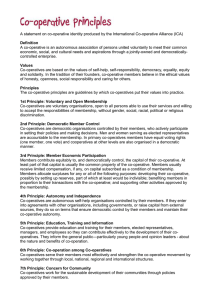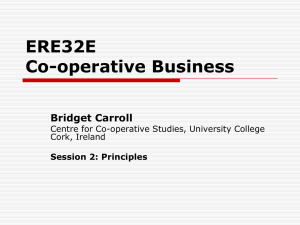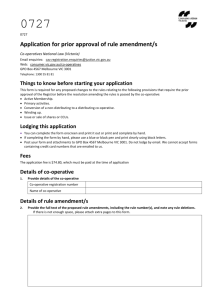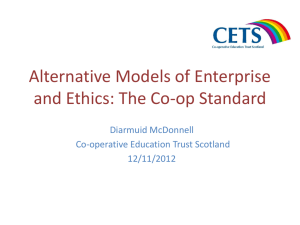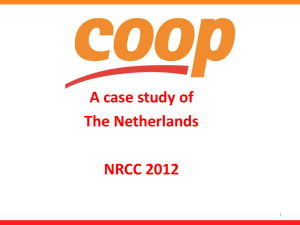Canada-Ontario Business Service Centre Co-operatives Info-Guide Last Verified: 2006-02-24
advertisement
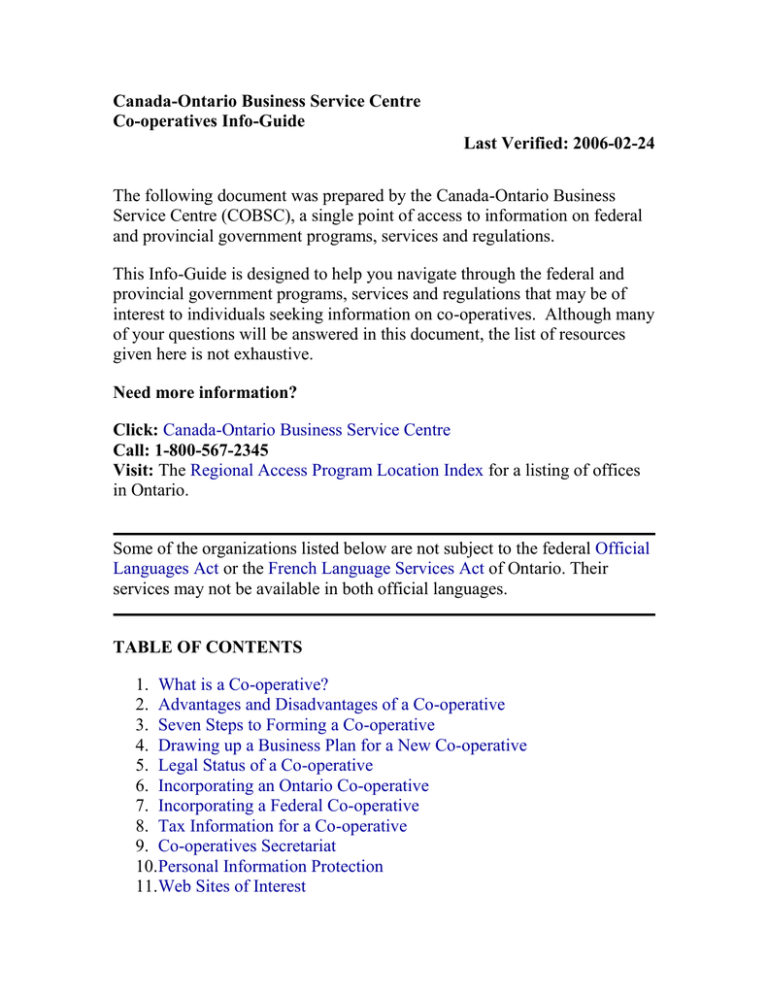
Canada-Ontario Business Service Centre Co-operatives Info-Guide Last Verified: 2006-02-24 The following document was prepared by the Canada-Ontario Business Service Centre (COBSC), a single point of access to information on federal and provincial government programs, services and regulations. This Info-Guide is designed to help you navigate through the federal and provincial government programs, services and regulations that may be of interest to individuals seeking information on co-operatives. Although many of your questions will be answered in this document, the list of resources given here is not exhaustive. Need more information? Click: Canada-Ontario Business Service Centre Call: 1-800-567-2345 Visit: The Regional Access Program Location Index for a listing of offices in Ontario. Some of the organizations listed below are not subject to the federal Official Languages Act or the French Language Services Act of Ontario. Their services may not be available in both official languages. TABLE OF CONTENTS 1. What is a Co-operative? 2. Advantages and Disadvantages of a Co-operative 3. Seven Steps to Forming a Co-operative 4. Drawing up a Business Plan for a New Co-operative 5. Legal Status of a Co-operative 6. Incorporating an Ontario Co-operative 7. Incorporating a Federal Co-operative 8. Tax Information for a Co-operative 9. Co-operatives Secretariat 10.Personal Information Protection 11.Web Sites of Interest 1.What is a Co-operative? A co-operative is owned by an association of persons seeking to satisfy common needs (access to products or services, sale of their products or services, employment, etc.). This association includes one or more kinds of users or stakeholders in the enterprise, such as: consumers who use the enterprise to acquire products or services (such as a retail housing, health-care or day-care co-operative) ; producers (such as independent entrepreneurs, artisans or farmers) who use the enterprise to process and market the goods or services they have produced, or to buy products or services necessary to their professional activities ; or workers who use the enterprise to secure their employment and control their working conditions. Co-operatives operate democratically (one person, one vote) through two bodies: general meetings of the members or delegates, and the board of directors, at least two-thirds of whom are members elected at a general meeting. The delegate structure may reflect the size of the organization or the distance covered by the co-operative and include more than one delegate for each organization or territory represented. The co-operative's start-up capital usually comes from co-operative shares purchased by members. Federal co-operatives, however, can raise capital by issuing investment shares to members or non-members. Each member's liability is limited to the amount of his or her share in the capital. Each member has only one vote regardless of his or her capital contribution. Purpose of a Co-operative The purpose of a co-operative is both economic and social. It may include, for example, social development or local economic development through job creation or the provision of goods and services that would be otherwise unavailable. Principles All co-operatives are guided by the same general principles as stated by the International Co-operative Alliance. These principles are: Voluntary And Open Membership ; Co-operatives are voluntary organizations, open to all persons able to use their services and willing to accept the responsibilities of membership. Democratic Member Control ; Co-operatives are democratic organizations controlled by their members, who actively participate in setting their policies and making decisions. Member Economic Participation ; Members contribute equitably to, and democratically control, the capital of their co-operative. At least part of that capital is usually the common property of the co-operative. Autonomy and Independence ; Co-operatives are autonomous organizations controlled by their members. If they enter into agreements with other organizations, including governments, or raise capital from external sources, they do so on terms that ensure democratic control by their members and maintain their co-operative autonomy. Education, Training and Information ; Co-operatives provide education and training for their members, elected representatives, managers and employees so they can contribute effectively to the development of their co-operatives. Co-operation Among Co-operatives ; Co-operatives serve their members most effectively, and strengthen the co-operative movement by working together through local, national, regional, and international structures. Concern For Community ; Co-operatives work for the sustainable development of their communities through policies approved by their members. Types of Co-operatives Financial Co-operatives ; These co-operatives offer financial, loan or investment services, and insurance services to their members. Financial Co-opeatives are owned by user members or by subscribers to insurance. Consumer Co-operatives ; They provide their members with goods for their personal use and are owned by the consumers of the goods sold by the co-operative. Consumer Co-operatives work in various sectors and range from small purchasing groups to large supermarkettype organizations. Service Co-operatives ; They provide services to their members (individuals or corporations). They are owned by the users of the services. Service Co-operatives can range in size from small day care centers to large housing co-operatives. Producer co-operatives ; Some co-operatives market, or process and market, their members' products and services directly. Others may also sell the input necessary to their members' economic activities (such as agricultural supply co-operatives). They are owned by members that purchase from them their inputs, or who deliver to them the products and services they market. Worker Co-operatives ; The purpose of these co-operatives is to provide their members with work by operating an enterprise and may be found in all economic sectors. These co-operatives are owned by their employee members. Worker Co-operatives are mainly part of the small or medium sized enterprise sector. In a worker co-operative, the members, who are the collective owners, obtain jobs and control the management and administration of their enterprise. Multi-Stakeholder Co-operatives ; The membership of these cooperatives is made of different categories of members who share a common interest in the organization, i.e. clients, workers, investors, community organizations etc. 2. Advantages and Disadvantages of a Co-operative Advantages owned and controlled by members; democratic control by one member, one vote; limited liability; profit distribution (surplus earnings) to members in proportion to use of service; surplus may be allocated in shares or cash. Disadvantages possibility of conflict between members; longer decision-making process; participation of members required for success; extensive record keeping necessary; less incentive to invest additional capital. 3. Seven Steps to Forming a Co-operative Phase I - Develop the co-operative business idea Step 1: Assemble a group of interested people Step 2: Conduct a feasibility study Phase II - Co-ordinate the pre-co-operative's activities Step 3: Hold an organizing meeting Step 4: Conduct a viability study Phase III - Organize and start up the co-operative Step 5: Organize the association Step 6: Organize the enterprise plan the operation of the enterprise ; plan and organize the enterprise's start-up financing ; recruit and train the enterprise's staff ; ensure the legality of the enterprise's operations. Step 7: Hold the initial general meeting For further information see the document Registration of a Co-operative 4. Drawing up a Business Plan for a New Co-operative A business plan is a document providing a complete description of the cooperative enterprise you wish to form. It describes in detail the products or services that will be produced or sold, the organization of work and the management approach, the results of the market study and the marketing plan, the characteristics of the paid and unpaid human capital (the members), equipment and material needed, financing requirements and the financing plan. For further information: visit the Web site: Developing the Business Plan of a New Co-operative http://www.agr.gc.ca/rcs-src/coop/index_e.php?s1=guides&s2=kit&page=10 5. Legal Status of a Co-operative A co-operative may be formed in accordance with: a provincial co-operative statute setting out its corporate form and mode of operation ; or the Canada Cooperatives Act when the co-operative has a place of business in at least two provinces. All co-operatives in Canada are incorporated under federal or provincial cooperative legislation. The degree of supervision and guidance offered to cooperatives varies from province to province. The federal statute and some provincial statutes recognize two kinds of co-operatives: co-operatives that get their financing from the sale of shares to members ; co-operatives that get their financing from loans from members. For further information: see the document Articles and Bylaws 6. Incorporating an Ontario Co-operative The Co-operative Corporations Act (CCA) is administrated by the Financial Services Commission of Ontario and governs the incorporation of Ontario co-operatives. If your business is only operating in Ontario then you must register your organization provincially. In Ontario, all co-operatives must file for incorporation with the Financial Services Commission of Ontario, Licensing and Enforcement Division of the Ministry of Finance. Provincial incorporation will not protect your corporation’s name or trademark outside of the province. If you are planning to conduct business outside of Ontario you will be required to apply for Federal incorporation. Applying for Incorporation The process of business incorporation has three major elements. Step 1: The first element is the name search; a professional search house must perform the name search. The name search report or NUANS (Newly Automated Name Search) report confirms that the name chosen for the cooperative does not already exist, and that no one else has a business or registered trademark with a name the same as, or similar to, the one you have chosen. You can find listings of these firms in your local phone book under the heading Searchers of Records. Step 2: Articles of Incorporation are then completed and filed with the Financial Services Commission of Ontario, Licensing and Enforcement Division of the Ministry of Finance. These are official documents required for incorporation that state the co-operative's name, purpose, share structure, directors and incorporators, and must be approved by the government before you can do business under that name. Step 3: The final element is the fee to file your application for incorporation that can vary based on your organizations structure. Please contact the Financial Services Commission of Ontario for specific information regarding fee structures. For further information: please call (416) 226-7776 (FSOC) visit these Web sites: The Co-operatives Secretariat http://www.agr.gc.ca/rcs-src/coop/index_e.php How to Register a Co-operative http://www.fsco.gov.on.ca/english/regulate/co-ops/register_co-ops.asp see the documents: Registration of a Cooperative Articles and Bylaws Regarding Cooperatives Cooperative Glossary Filing Requirement and Record-Keeping outlines the routine information that co-ops send to FSCO, such as annual financial statements. This guide also describes the records that the Co-operative Corporations act requires coops to keep. For further information: visit the Web site: Filing Requirement and Record-Keeping http://www.fsco.gov.on.ca/English/regulate/co-ops/register_co-ops-2.pdf 7. Incorporating a Federal Co-operative The Canada Cooperatives Act governs the incorporation of federal cooperatives. Cooperatives are business organizations owned by the members who use their services. They are a separate legal entity which may enter into contracts in their corporate name. Generally, each member of a cooperative is entitled to one vote. Surpluses are shared by members in proportion to the degree they use the services. The members elect the board of directors and decide what should be done with any profit that is generated in the coop. To apply for incorporation, at least three persons, or one or more federation, must send the Director, appointed under the Canada Cooperatives Act , the following: Articles of Incorporation, Form 3001 Notice of Registered Office, Form 3003 Notice of Directors, Form 3006 A declaration signed by all the applicants that, after incorporation, the cooperative will be organized and operated and will carry on business on a cooperative basis. If the proposed cooperative is a non-profit housing cooperative or a worker cooperative, a declaration signed by all the applicants that the cooperative will be in compliance with either Part 20 or 21 of the Canada Cooperative Act . Part 20 includes specific provisions applicable to non-profit housing cooperatives and Part 21 includes specific provisions applicable to worker cooperatives. A name search report, specifically a Canada-biased NUANS report. The name must not be confusing with other names, including corporate names, and it must include the word "co-operative", "cooperative", "co-op", "coop", "coopérative", "united" or "pool" or another grammatical form of any of those words. Publications offered by the Corporations Canada: Amalgamation Kit (for cooperatives that want to amalgamate to form a single cooperative); Amendment Kit (for incorporated or continued cooperatives that want to amend their existing articles under the Canada Cooperatives Act); Continuance Kit (for cooperatives currently incorporated under Canadian legislation other than the Canada Cooperatives Act that wish to continue or move into the later); Incorporation Kit (to incorporate a cooperative under the Canada Cooperatives Act). For further information: visit the Web site: Canada Cooperatives Act http://laws.justice.gc.ca/en/C-1.7/index.html Filing Requirements under the Canada Cooperatives Act Save Money and Time by Filing Online You can also complete and file documents online (via Internet) and pay electronically in a secure environment through the Online Filing Centre. For further information: visit the Web site: Online Filing Centre http://strategis.ic.gc.ca/epic/internet/incd-dgc.nsf/en/h_cs01422e.html Online filing offers many benefits: convenience - file from anywhere at any time - the Online Filing Centre is open 24/7; reduced delivery costs - traditional delivery expenses and delays are eliminated with online submissions ; immediate acknowledgement of filing - no more guessing as to whether your submission has been received ; prompt processing of articles - electronic submissions direct to a database enable Corporations Canada to offer expedient processing within either the same day or next day turnaround, depending on the time of filing and complexity of the application ; reduced fees for incorporation and the filing of annual returns the incorporation fee has been reduced to $200, while the fee for filing annual returns has been reduced to $20. You can pay using your Visa®, Mastercard® or American Express® credit card. All transactions are secure. Online filing is optional. It provides you, as well as the Director, with more options for sending or issuing documents under the CBCA. For further information: please call 1-800-333-5556 visit the web site: Corporations Canada-Where to start? http://corporationscanada.ic.gc.ca/epic/internet/incddgc.nsf/en/home?OpenDocument see the document Federal Co-operatives 8. Tax Information for a Co-Operative Co-operatives in general will be subject to the same taxes as other business types and potentially fall into one of these categories: Producer, Consumer, or Worker with a Corporation Return form filed within 6 months after the end of each fiscal year. Incorporated organizations are required under the Income Tax Act to file a T2 or T2 Short return, and all corporations doing business in Ontario are required to file a separate tax return with the Ministry of Finance. Information provided here is simply a general guide and you should consult with an accountant or financial professional for more specific information regarding the tax requirements for your organization. For further information please call 1-800-263-7965 visit these Web sites: Corporations http://www.cra-arc.gc.ca/tax/business/topics/corporations/menu-e.html Corporations Canada http://strategis.ic.gc.ca/epic/internet/incd-dgc.nsf/en/home?OpenDocument see the documents: Taxation Info-Guide Income Tax Returns - the T2 Corporate Income Tax Return and the T2 Short Return Internet Publications Corporation tax return Web site: http://www.craarc.gc.ca/tax/business/topics/corporations/return/menu-e.html T4012, T4012 T2 Corporation - Income Tax Guide 2004 Web site: http://www.cra-arc.gc.ca/E/pub/tg/t4012/README.html TheT2 Corporation Income Tax Return is an eight-page return that serves as a federal and provincial/ territorial corporation income tax return. Exceptions: corporations located in Quebec, Ontario or Alberta. If the corporation is located in one of these provinces, it has to file a separate provincial corporate return. The T2 Short is a two-page return designed for small, non-taxable corporations with a gross annual income of $500 000 or less. The T2 Short return is a simpler version of the T2 Corporation Income Tax Return. Two categories of corporations are eligible to use the T2 Short. 9. Co-operatives Secretariat The Co-operatives Secretariat is an agency established in 1987 to help the federal government respond more effectively to the concerns and needs of co-operatives. The Co-operatives Secretariat publishes an information kit called Creating a Co-operative - An Information Guide, which can be obtained by calling the Co-operatives Secretariat or can be viewed on the Internet at http://coop.gc.ca/index_e.php?s1=guides&s2=kit&page=intro To view a list of online publications published by the Co-operatives Secretariat, visit http://coop.gc.ca/index_e.php?s1=pub&page=intro For further information: please call (613) 759-7194 visit the web site: The Co-operatives Secretariat http://coop.gc.ca/index_e.php?s1=pub&page=intro see the document Co-operatives Secretariat 10. Personal Information Protection Personal Information Protection - Privacy Commissioner of Canada The Guide to Canada's Personal Information Protection and Electronic Documents Act (PIPEDA) helps businesses understand their obligations and comply to the Act. On January 1, 2004, the PIPED Act will cover the collection, use or disclosure of personal information in the course of all commercial activities in Canada, except in provinces which have enacted legislation that is deemed to be substantially similar to the federal law. For further information: please call 1-800-282-1376 visit the web site A Guide for Businesses and Organizations http://www.privcom.gc.ca/information/guide_e.asp see the document Protection of Personal Information - Your Responsibilities 11. Resources and Web Sites of Interest Ontario Co-operative Association http://www.ontario.coop/ Ontario Cooperative Education Association http://www.ocea.on.ca CoopZone http://www.coopzone.coop/ Building Community Assets: the Co-op Advantage http://www.buildingcommunityassets.coop/ Cooperatives (Canada Cooperatives Act) http://strategis.ic.gc.ca/epic/internet/incd-dgc.nsf/en/h_cs02151e.html Canadian Co-operative Association http://www.coopscanada.coop/ Conseil Canadien de la Coopération http://www.ccc.coop/francais/accueil/accueil.asp (site available in French only) Related Reading Important Notices Co-operative Development Initiative (CDI) Business Guides Available at the COBSC New Generation Co-operatives for Agricultural Processing and Value Added Projects Cooperative Glossary Cooperative Structure Cooperative Governance Co-operative - Business Structure Financing and Financial Management for Cooperatives Forms of Business Organization
